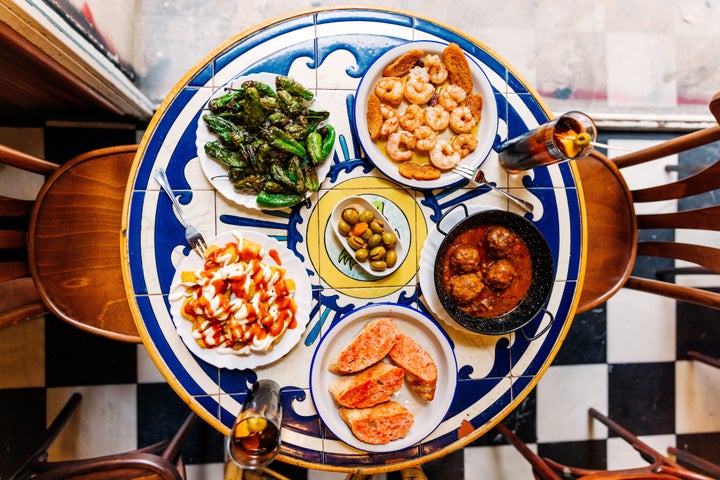
As a trendologist at Datassential, a food and beverage market research firm, it’s Mike Kostyo’s job to spot trends before they happen. Want to know which brunch food is about to replace avocado toast, or which plant-based food substitute everyone will be buying next? He’s your guy. How exactly does one become a food trendologist and what does he do all day? Here, Kostyo explains all the details — plus, the trends he predicts will take over the food space next.
From the outside, food trends seem to burst out of nowhere. When exactly was it that every single cafe decided to start adding oat milk to menus, or that cauliflower pizza became so mainstream that even California Pizza Kitchen started selling it? Remember when Brussels sprouts seemed to become an appetizer at every buzzy restaurant? Or when bacon was added to everything?
To the average eater, these trends happen without rhyme or reason, but Mike Kostyo knows why. He literally studies how we eat and drink, which is valuable information that companies pay to learn. A food trendologist — Kostyo’s job — identifies trends before they happen based on data and research.
“I do feel a lot of pressure,” Kostyo explained, because his client food and drink companies “use that information and it affects their jobs.”
“The trends we predict can affect if they have a good quarter and may even affect whether or not people get to keep their jobs.”
So, what exactly goes into calling something a trend and how does one become a food trendologist in the first place? As you might expect, it starts with a love of food.
How to become a food trendologist
Kostyo used to work in politics, in the communications department for the Indiana Senate Democratic Caucus and later for Hillary Clinton’s 2008 presidential campaign.
“I spent a lot of time in Iowa, talking to farm families and getting involved in some of the issues that are relevant to farmers,” Kostyo said of his work for Clinton. This got him thinking that it might be interesting to pursue a career that combined politics and food.
At the same time, Kostyo said something he really loved about campaign life was mealtime with the people on his team. “Food was a real thrill point on the campaign. We were a bunch of young people who just graduated college and spent a lot of time together either cooking at each other’s houses or going to restaurants together,” he said.
When the campaign ended and Kostyo was trying to figure out his next move, he thought back to how much he loved the food moments of his job, whether it was eating with his work friends or talking about food issues with farmers. This led him to enroll in a gastronomy program at Boston University.
“I thought I would go into food politics, but what I really liked was learning about food anthropology, the study of food in a social and cultural setting,” Kostyo said.

Insider tip: If you want to become a food trendologist, classes on food anthropology are a good place to start. In these classes, you learn the role food plays in society, such as what people tend to eat when the economy takes a nosedive and the food traditions of various cultures.
After Kostyo completed the gastronomy course, he was hired as a trendologist at food and beverage market firm Datassential, where he works today.
A day in the life
Kostyo explained that declaring something a trend requires actual data; it’s not done willy-nilly. A lot of his job is spent analyzing data to prepare food trend reports he and his team put together a few times a year. Some brands and companies use these trend reports to determine products they may want to create.
“We have our eyes on all sorts of possible trends, with dedicated folders for each. Any time we come across a piece of data or anecdotal evidence related to a possible trend, we add it to the designated folder,” Kostyo said, explaining that this allows them to see how a trend is building over time (or if it fizzles out, never actually turning into one).
For example, he said he and his team use a tool that gives them access to more than 100,000 menus across the country.
“We can use this tool to see what types of appetizers have grown the fastest in the past few years or what ingredients are being used more,” Kostyo said.
Then there’s the other part of the job: eating.
“I go on immersion tours, which involves taking clients to many different restaurants in a certain city — maybe 20 restaurants — to gain insight into what is trending in that particular city,” Kostyo said.
Something Kostyo has to keep in mind is the difference between a trend and a fad. “Trends have long legs and reflect something larger happening in our society, but a fad is something that has quick growth — typically driven by social media — and then fizzles out quickly,” he said.
Examples of a fad: Emily Mariko’s salmon bowl that went viral on TikTok, or the “healthy Coke” made with balsamic vinegar and sparkling water people are trying now.
Kostyo said it’s also important to be aware of one’s own biases and to be mindful of how certain foods and ingredients — especially ones with a rich cultural history — are framed. For example, is it right to call turmeric a trend when it’s been used for centuries in Indian cuisine?
“We have these types of conversations a lot,” Kostyo said. “What we try to do is simply communicate something’s growth. For example, relay that a certain ingredient has grown 40% in terms of being mentioned on menus in the past year.”
Trends that have taken him by surprise — and what’s about to take over next
As Kostyo explained again and again, food trends are built on data. Sometimes, the growing data surrounding certain foods has taken him by surprise. One involves eating insects. It’s something Kostyo said has never truly reached trend status, despite several brands really trying to push it as a sustainable protein source.
But then word got out that the Seattle Mariners were eating flavored grasshoppers and crickets for protein. Every season, grasshoppers and crickets would sell out at the ballpark because people wanted to eat just like the Mariners. Sometimes, Kostyo said, it just takes one celebrity (or in this case, a team) to officially turn something into a trend.
You may be wondering if Kostyo ever gets it wrong. Has he ever called something a trend only for it to never really become one? Yep, it’s happened.
“Sometimes, we’ll keep track of a trend, but all of the sudden it will fall off,” he said. This typically happens when something unpredictable happens on a national or global level, like, say, a pandemic, a war or inflation. Global events affect what we eat more than we may realize.
“The Ukrainian-Russian War is affecting wheat production, so anything involving flour is going to be affected by that,” Kostyo said. If you see breweries getting creative with their Oktoberfest beers, making them with gluten-free grains instead of wheat, the shortage could be a major reason.
This shows Kostyo did end up working in food politics, in a way. After all, one of the big lessons of the pandemic was that food is political, whether it has to do with the supply chain or the well-being and rights of farmers, factory workers, and grocery store employees.
What will we all be eating next? Kostyo said to keep an eye out for plant-based seafood, along the lines of plant-based meat. For more of his predictions, you’ll have to wait for his next report. After all, there’s no such thing as free lunch.
